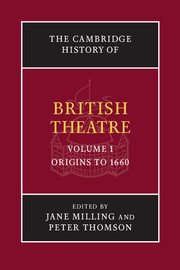Book contents
- Frontmatter
- PART I PRE-ELIZABETHAN THEATRE
- PART II ELIZABETHAN THEATRE
- PART III JACOBEAN AND CAROLINE THEATRE
- 13 Working playwrights, 1580–1642
- 14 Theatre and controversy, 1603–1642
- 15 The Stuart masque and its makers
- 16 Clowns, fools and knaves: stages in the evolution of acting
- 17 Thomas Middleton's A Game at Chess: a case study
- 18 The condition of the theatres in 1642
- 19 Theatre and Commonwealth
- Works Cited
- Index
- References
16 - Clowns, fools and knaves: stages in the evolution of acting
from PART III - JACOBEAN AND CAROLINE THEATRE
Published online by Cambridge University Press: 28 March 2008
- Frontmatter
- PART I PRE-ELIZABETHAN THEATRE
- PART II ELIZABETHAN THEATRE
- PART III JACOBEAN AND CAROLINE THEATRE
- 13 Working playwrights, 1580–1642
- 14 Theatre and controversy, 1603–1642
- 15 The Stuart masque and its makers
- 16 Clowns, fools and knaves: stages in the evolution of acting
- 17 Thomas Middleton's A Game at Chess: a case study
- 18 The condition of the theatres in 1642
- 19 Theatre and Commonwealth
- Works Cited
- Index
- References
Summary
Of the 800 performers traced by Edwin Nungezer for inclusion in his Dictionary of Actors and of Other Persons Associated with the Public Representation of Plays in England before 1642 (1929), upwards of thirty can be identified as professional clowns or fools, but not one can be confidently said to have been both clown and fool. The first task of this essay is to distinguish between these two roles.
The clown
The word ‘clown’ is an Elizabethan importation to the English language. It came into currency because it usefully distinguished those who used it from those they used it about. ‘Clowns’ were rustic and therefore boorish, the polar opposites of the courtly sophisticates whose concern it was to establish anew a code of gentility for the great and the good in Elizabethan England. It is in this sense, for instance, that Robert Greene uses the word in the opening stage direction to the third scene of Friar Bacon and Friar Bungay ( c. 1589): ‘Enter Margaret the faire Mayd of Fresingfield, with Thomas and Ione, and other clownes’; and it is in this sense that the mechanicals of A Midsummer Night's Dream are all clowns. In the Elizabethan theatre, though, such generic definitions are of less use to the performers than to the tireman who must costume them. The lively encounter between actor and audience on the platform stage begins with the recognition that, unique among clowns, Bottom is the Clown.
Distinct from the history of drama, the history of theatre is signposted by transcendent performers, and the first great artist of the English stage was a clown. Richard Tarlton (d.1588) was qualified to speak for the rustic immigrants to the great city of London because he was one himself. Biographical information is scanty and contradictory (he was a swineherd in Shropshire; he was from Essex, where he learned the publican's trade; he was apprenticed to a water-carrier), but that is not surprising in the case of a man who was anecdotally mythologised during his own lifetime and in the decades immediately following his death.
- Type
- Chapter
- Information
- The Cambridge History of British Theatre , pp. 407 - 423Publisher: Cambridge University PressPrint publication year: 2004



